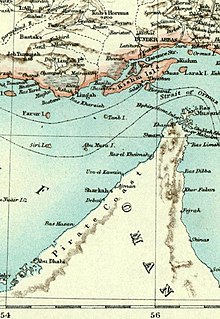Territorial disputes in the Persian Gulf
These states include Iran, Iraq, Kuwait, Saudi Arabia, Bahrain, Qatar, the United Arab Emirates (UAE), and Oman.
The concept of the modern state — introduced into the Persian Gulf region by the European powers — and the sudden importance of boundaries to define ownership of oil deposits kindled acute territorial disputes.
The last shah of Iran, Mohammad Reza Pahlavi, raised the Bahrain issue with the British when they withdrew from areas east of the Suez Canal by 1971.
[5][4] On 12 May 1986, following protests by the Netherlands and mediation by several GCC member states, Bahrain and Qatar reached a settlement, after which the foreign workers were released.
[5] In 1991 the dispute flared up again after Qatar instituted proceedings to let the International Court of Justice (ICJ) in The Hague, Netherlands, decide whether it had jurisdiction.
The Ottoman Empire exercised a tenuous sovereignty over Kuwait in the late nineteenth century, but the area passed under British protection in 1899.
In 1961, after Kuwait's independence and the withdrawal of British troops, Iraq reasserted its claim to the emirate based on the Ottomans' having attached it to Basra Province.
During the 1980-88 Iran–Iraq War, Iraq pressed for a long-term lease to the islands in order to improve its access to the Persian Gulf and its strategic position.
Although Kuwait rebuffed Iraq, relations continued to be strained by boundary issues and inconclusive negotiations over the status of the islands.
[9] Smaller incidents have also arisen, primarily along the major road joining the two countries at the border control station known as "K Crossing.
[15] Two disputes exist between the two countries over the territorial waters claimed through the land owned by Saudi Arabia between Qatar and the United Arab Emirates.
A particularly long and acrimonious disagreement involved claims over the Al Buraimi Oasis, disputed since the nineteenth century among tribes from Saudi Arabia, Abu Dhabi, and Oman.
Although the tribes residing in the nine settlements of the oasis were from Oman and Abu Dhabi, followers of the Wahhabi religious movement that originated in what is now Saudi Arabia had periodically occupied and exacted tribute from the area.
In the late 1940s, Aramco survey parties began probing into Abu Dhabi territory with armed Saudi guards.
Matters came to a head with a non-violent confrontation between Abu Dhabi and Saudi Arabia in 1949 known as the "Stobart incident", named after a British political officer of the time.
After the British withdrew from the Gulf, a settlement was reached between Zayed bin Sultan Al Nahyan of Abu Dhabi and King Faisal of Saudi Arabia.
[1] In March 1990 Saudi Arabia settled her borders with Oman in an agreement that also provided for shared grazing rights and use of water resources.






